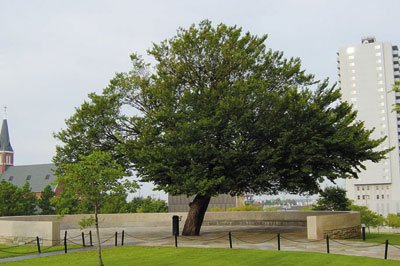When last I left you, we were in Oklahoma City, site of the
Garden Writers Association’s national symposium. Today, I’d like to
talk about the Survivor Tree. It is an 80-year-old American elm
tree in the heart of Oklahoma City that became a living symbol on
that fateful day in 1995 when a huge truck bomb destroyed the
nine-story Alfred P. Murrah Federal Building.
When last I left you, we were in Oklahoma City, site of the Garden Writers Association’s national symposium. Today, I’d like to talk about the Survivor Tree. It is an 80-year-old American elm tree in the heart of Oklahoma City that became a living symbol on that fateful day in 1995 when a huge truck bomb destroyed the nine-story Alfred P. Murrah Federal Building. Some 168 people, including 19 children who attended the daycare there, died.
Today, the Oklahoma City National Memorial and Museum sits on the now-sacred soil, capturing and preserving forever the place and events that changed the world on April 19, 1995. The Survivor Tree stands as a profound symbol of human resilence. The tree not only nearly died from the blast, but also was almost cut down in order to recover pieces of evidence that hung from its branches. The massive bomb eventually resulted in 16 surrounding buildings being demolished, with windows broken from buildings as far away as 12 miles.
The Memorial itself is as impressive as any memorial you would find in Washington, D.C. The Field of Empty Chairs is moving and beautiful at the same time. There are 168 empty chairs – one representing each of those who died. The chairs are placed in nine rows, representing the nine floors of the building. The chairs are placed according to the floor on which those killed were. The symbolic chairs are designed in two sizes, with the smaller ones representing the 19 children. By day, the chairs seem to float above their translucent bases. By night, the glass bases illuminate as beacons of hope.
Two monumental gates mark the formal entrances to the Memorial and frame the moment of destruction: 9:02 a.m. The east gate represents 9:01 and marks the innocence of the city before the attack. The west gate represents 9:03, the moment we were changed forever. A giant reflecting pool stretches from one side of the Memorial to the other. Off to one side, raised well above the reflecting pool is the Survivor Tree.
Oklahoma City Urban Forester Mark Bays told me that the American elm tree was the lone tree that survived the bombing. It stood less than 75 yards from where the bomb detonated.
“It was almost cut down to collect evidence, plus the fact that it was in such bad shape,” Bays said. “One whole side of the tree was gone. It basically was a v-shape with only two branches and nothing else.”
However, the tree became a “tree of hope,” with people hanging signs of remembrance on it. They gathered there the day the guilty verdict was read for the bomber.
“We knew we had to protect the Survivor Tree,” Bays said.
It wasn’t an easy job. Asphalt had bowed up onto the tree, and workers had to jack-hammer the asphalt away without doing further damage to the tree. The compacted red clay underneath the asphalt was then broken up with picks and shovels, again to prevent further damage. Truckloads of organic mulch was brought in. Bays explained that workers even gave a major root it’s own little tunnel to grow and expand in rather than cutting it.
Today, the Survivor Tree sits in a circular promontory. The tree offers a place for gathering and viewing the memorial. The message to visitors: “The spirit of this city and this nation will not be defeated; our deeply rooted faith sustains us.”
For more information on the Memorial and Museum, visit www.oklahomacitynationalmemorial.org or call (405) 235-3313.












